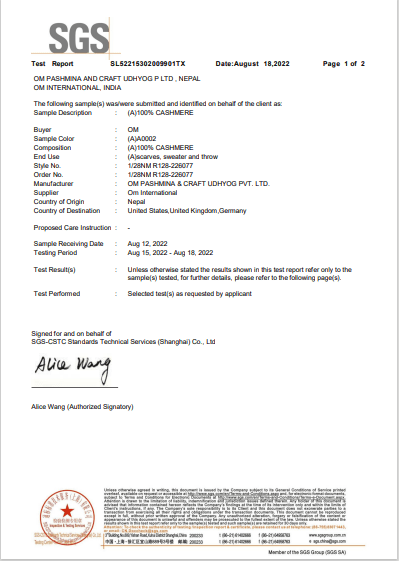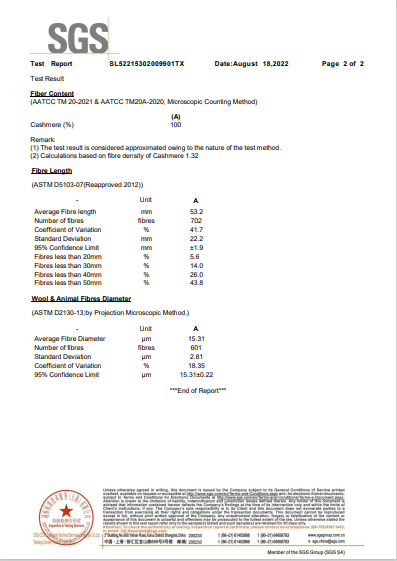Cashmere Yarn Quality Certificate


Quality Check and Assurance
Cashmere is the most sought-after fabric that endures through time. It celebrates timeless excellence through luxury finished products by fusing innovation and tradition.
One of the most important elements of our business is quality. Customers demand and anticipate value for their money. As leading Cashmere manufacturers, we continuously strive to produce high-quality products.
At our facility, Indo-Nepalese artisans are the only means of guaranteeing the highest quality of cashmere garments. Through years of practice, these artisans have refined their craft of turning cashmere yarn into a beautiful work of art.
As we grew, we developed mutually beneficial, long-term relationships with our raw material suppliers, skilled craftsmen, knitters, and weavers, who embody the best of the skills we strive to represent and promote internationally.
Every stage of this delicate process, from choosing the yarn to producing the finished item, is meticulously crafted to produce a garment that will last a lifetime: a testament to the best craftsmanship that speaks of culture and legacy.
Initially, a flat hand machine and hand knitting are used to knit the cashmere threads separately and then to size. As a principle, this procedure has remained unchanged since the 18th century, except for the speed and accuracy of the manufacturing machinery involved. Mater craftsmen oversee the entire process, from beginning to end to guarantee that each item is perfect and ready for further processing.
Expert hands stitch cashmere pieces into perfect seams by hand or by machine, following a painstaking century-old technique that requires all seams to be perfectly aligned. An exquisite raw material, meticulously finished by experienced craftsmen, guarantees a premium-quality final product.
Even if the garment appears to be finished now, more steps are still needed to guarantee the cashmere’s quality and enduring, rich feel. A critical stage in enabling clothing to take on its final shape and acquire the softness typical of this material is washing the item using specialised solutions that contain minimal to no chemicals.
Last but not least, skilled artisans with a keen eye for detail handcraft the label attachment and finishing touches. The ironing and final control procedures that verify the final product’s quality and size come next. The cashmere garment is given a 24-hour rest period once it has been finished to allow the fabric to cool and release the steam.
Unlocking 6 Secrets of Cashmere Quality: How to tell if cashmere is good quality
It’s really easy to define the best quality cashmere:
- The staple length is 34- 36mm.
- And the micron is 14-15.5 microns
OK, great!
So I’ll just take my microscope shopping then to check the micron and I’m sure that snooty salesperson over there won’t mind if I pull out a few fibres from this cashmere sweater to check the staple length.
So what else can you look for if the microscope is not an option?
- Softness: cashmere is synonymous with softness so it goes without saying that you should be able to feel the quality as soon as you touch it. No ‘crunchiness’ or ‘soapyness’ should be under your fingertips. Running your hands across the fabrics should feel smooth and luxurious.
- Fibre Length: OK, microscopes aside. If you look closely at the fabric, can you see the fibres coming up and how long are they? If you can see more of them, this is a bad sign. The longer fibres are a sign of carefully selected, meticulously combed cashmere. The longer length means it will be more durable and last longer.
- Pilling: which brings us neatly to the pilling. Pilling is every knitwear lover’s nightmare. The little balls of intertwined fibres that form on the surface of the fabric, ruining the look and feel of the garment. When that snooty salesperson isn’t watching too closely, rub the surface of the cashmere fabric, can you start to see fibres gathering together- this is a red flag and means that the garment is lower quality.
- Warmth and Insulation: Personally, I love to wear cashmere when it’s rainy. When you pull on the cashmere garment it should feel warm but without any bulk or heaviness.
- Color Vibrancy: A vibrant and lustrous appearance is another characteristic of high-quality cashmere. Looking closely at the cashmere and see how the color reflects light. Rich, vibrant hues indicate that white fibres have been used and that the dyes are high quality, ensuring your cashmere maintains its brilliance for years to come. Keep in mind that neon, black and navy colourways will always have worse handfeel than light and ‘goat’ coloured fibres because they will have taken up more dye to achieve the desired look.
- Finishing Details: Attention to detail is a mark of true craftsmanship. Examine the seams, linking, and overall finish of the cashmere garment. High-quality cashmere will showcase precise stitching, even seams, and impeccable craftsmanship. These small details speak volumes about the care and expertise that went into creating the piece. Hold the fabric up to the light to check for an even and smooth knitting pattern. Verify that seams are straight and well-aligned, stripes match, and loose ends are properly handled.